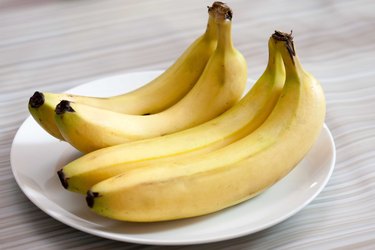
Have you just bought a bunch of bananas and want to make sure they'll stay fresh? With a little know-how, you can keep bananas from turning brown and increase their shelf life. Simple tricks, such as using a light coating and wrapping your fruits in plastic or paper, can help prevent oxidation.
Why Do Bananas Go Brown?
Video of the Day
With their sweet aroma and smooth texture, bananas make a healthy dessert year-round. Unfortunately, they have a shorter shelf life than most fruits and can go bad within days. Browning is part of the ripening process and occurs due to ethylene gas and polyphenol oxidase (PPO).
Video of the Day
Ethylene, a plant hormone, is naturally produced by most fruits and plays a key role in ripening and cell aging, reports a May 2019 review published in the International Journal of Food Science.
Climacteric fruits, such as apples, guavas, bananas, papayas, avocados and peaches, release the highest amounts of ethylene gas and continue to ripen after harvesting. Cherries, lemons, grapefruits, melons and strawberries, on the other hand, are non-climacteric fruits and won't ripen after being picked.
Read more: Do Overripe Fruits Cause Gastric Distress?
Another culprit is polyphenol oxidase. This enzyme triggers oxidation, causing fruits and vegetables to turn brown. Apples, bananas, grapes, apricots, potatoes and cucumbers are the most vulnerable to its side effects. Cooking, dehydration, microwaving and other treatments deactivate PPOs and may help reduce browning.
Keep Bananas From Turning Brown
Ripe bananas taste amazing and boast higher antioxidant levels compared to their green counterparts. They also contain more sugar and vitamin C, according to a review featured in the December 2013 edition of the International Food Research Journal. The problem is that they can quickly go bad and develop mold, so you might end up throwing them away.
Read more: 16 Surprising Facts About Bananas
The Greater Chicago Food Depository states that it's perfectly safe to eat these fruits unless they're extremely ripe. Those small black pits on the peels or brown spots on the flesh don't pose any health risks. Beware, though, that storing bananas and other ethylene-producing fruits next to ethylene-sensitive veggies, such as cabbage, broccoli, green onions, leeks and mushrooms, may cause the latter to spoil.
There are a couple of things you can do to keep bananas from turning brown. Adequate storage is paramount. One way to increase their shelf life is to wrap them in plastic and store them in the fridge, as recommended by Philadelphia magazine. This will prevent ethylene from escaping and slow the ripening process.
Another trick is to coat the bananas with citrus juice, such as orange, lemon or lime juice, say the experts at the University of Nebraska-Lincoln. This method, though, only works for pre-cut fruits. Basically, if you slice a banana or cut in half for later use, coat it with an acidic juice before refrigerating it. You can also apply commercial anti-darkening agents, which have a similar effect.
According to the same source, it's possible to keep cut bananas from turning brown by mixing them with oranges, grapefruits and other acidic fruits. This is something to keep in mind when preparing fruit salads. Just make sure you first cut the acidic fruits and then add banana, apple or pear slices.
Choose the Right Packaging Materials
There's a reason why it's recommended to wrap bananas in plastic before refrigerating them. This simple trick can significantly increase shelf life by preventing premature browning.
A September 2012 study published in the Journal of Food Science assessed the effects of packaging on green banana quality and shelf life. Researchers compared four packaging materials versus no packaging and focused on several quality indicators, such as the peel color, pulp thickness and marketability. They concluded the following:
- Packaged fruits maintained their quality for up to 36 days.
- Unpackaged bananas ripened faster and had a lower pulp dry matter.
- High-density and low-density polyethylene bags were the most effective at increasing shelf life.
- Plastic packaging materials yielded better results than teff straw (an annual cereal grass) and dried banana leaf packaging or no packaging at all.
These findings indicate that polyethylene works best for storing bananas. Ziploc bags, for example, are made from this material. The next time you buy a bunch of bananas, put them in resealable plastic bags to keep them fresh for longer.
Read more: 10 Desserts That Won't Derail Your Diet
If your bananas are already fully ripe, use them in smoothies and milkshakes, puddings, banana bread, homemade energy bars and baked goods. Try creamy banana nut butter or high-protein banana oat pancakes for a tasty treat!
- International Journal of Food Science: "Induced Ripening Agents and Their Effect on Fruit Quality of Banana"
- International Journal of Molecular Sciences: "Polyphenol Oxidases in Crops: Biochemical, Physiological and Genetic Aspects"
- International Food Research Journal: "Changes in Antioxidant Properties and Chemical Composition During Ripening in Banana Variety ‘Hom Thong’ (AAA Group) and ‘Khai’ (AA Group)"
- Greater Chicago Food Depository: "Salvageable Fruit and Vegetable Guidelines"
- Produce for Better Health Foundation: "About the Buzz: Certain Fruits and Vegetables Should Not Be Stored Together?"
- Philly Mag: "How to Keep Bananas From Turning Brown"
- University of Nebraska-Lincoln: "How to Prevent Cut Fruit From Turning Brown"
- Journal of Food Science: "Effect of Packaging Materials on Shelf Life and Quality of Banana Cultivars (Musa Spp.)"
- Recycle Nation: "Ziploc Bags, aka Sandwich Bags or Resealable Plastic Bags, Are Starting to Be Accepted at More Recycling Facilities Across the Nation"